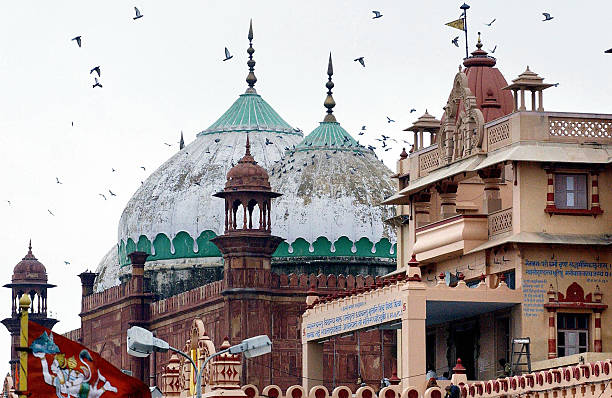Within 11 months of the historic Shri Ram Janmabhoomi verdict which was given by the Supreme Court, the struggle to reclaim Shri Krishna’s birthplace has also been initiated legally, as a team of devotees have now moved a Mathura court on behalf of Bhagwan Sri Krishna Virajman, seeking the removal of the 17th century Shahi Idgah Mosque, which was built on the orders of the tyrant – Aurungzeb over the ruins of Shri Krishna’s temple. The Mathura court will hear the matter regarding the Krishna Janmabhoomi-Idgah row on September 30 on the issue of maintainability of the petition filed by Krishna devotees. The court will decide on September 30 whether to admit the plea or not.
The fresh suit filed by Sri Krishna Virajman through petitioner-lawyer Ranjana Agnihotri said, “UP Sunni Waqf Board, Trust Masjid Idgah or any member of Muslim community have no interest or right in the property of Katra Keshav Dev over an area measuring 13.37 acres and entire land vests in the deity Bhagwan Sri Krishna Virajman.” If the plea is admitted, notices will be issued to the Central Sunni Waqf Board, the Shahi Idgah mosque and the trust which is administering the mosque.
The Ram Janmabhoomi verdict, which came after years of struggle on the part of Hindus, had opened the floodgates for devotees to reclaim their places of worship, over which illegal structures have been built by medieval plunderers. It must be mentioned that two disputed sites, viz., the Shri Krishna Janmabhoomi at Mathura, in the complex of which the Shahi Idgah stands too; and the Kashi Vishwanath Mandir at Varanasi, which has been converted into the Gyanvapi Mosque, are places of worship which Hindus have wanted to be reclaimed in their full glory, almost parallelly to demands of resolving the Ram Janmabhoomi dispute.
With the filing of the petition asking for the eviction of the Shahi Idgah Mosque from the Shri Krishna Janmabhoomi complex, the petitioners who have moved the court on behalf of the deity have effectively signalled that the struggle for the remaining temples is still very much on, and that Hindus have not forgotten about their other sites of worship illegally occupied by others, in the face of last year’s victory in the Ram Janmabhoomi case. If anything, the Supreme Court’s judgement last year should serve as an inspiration for the community to pursue legal remedies in the case of other disputed sites as well.
A major hindrance to such reclamation, however, is the Places of Worship (Special Provisions) Act 1991, which states that all places of worship, irrespective of religion, shall continue to operate, without hindrance and obstruction, as the exact worship sites which stood on August 15, 1947. By virtue of the same, for example, if a Mosque is built over a temple, and the superimposed structure existed as on 15th August 1947 in its present form, then no action can be taken to change the place of worship’s current form.
The Places of Worship Act was brought in 1991, by the then PV Narsimha Rao government, at a time when the Ram Mandir movement was at its peak. Its aim was simple – to be made to appear secular, however, to prevent Hindus from initiating a temple reclamation drive across India. While the Ayodhya dispute was exempted of the same, the other temples were declared out of bounds for Hindus to turn their eyes towards.
In the case of Shri Krishna Janmabhoomi, however, the illegality of the structure alongside the Mandir can be well established, as the Mosque visibly stands in the complex where Hindus believe Bhagwan Shri Krishna was born. Similarly, in case of the Gyanvapi Mosque in Varanasi, the same illegality is even more brazenly visible, as the mosque has been built on the foundations of the Kashi Vishwanath Temple itself.
In order for Hindus to reclaim what rightfully belongs to them, the Places of Worship (Special Provisions) Act, 1991 must be declared null and void. In the absence of the same, the road of reclamation will be an arduous one, with no guaranteed success, because while the Ram Janmabhoomi was exempted from the Act, there is no surety of the other two sites having the same luxury.
